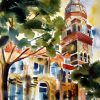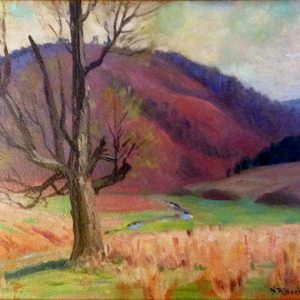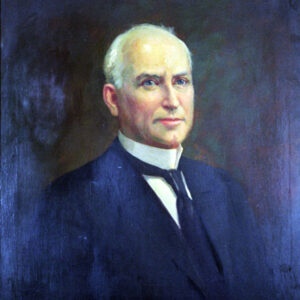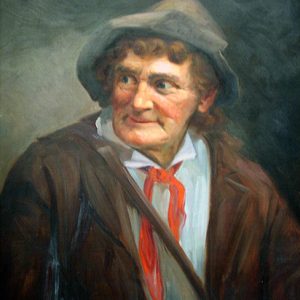calsfoundation@cals.org
Nicholas Richard Brewer (1857–1949)
Nicholas Richard Brewer was an American landscape and portrait artist. He was active in Arkansas during the early twentieth century and is best remembered in the state as the father, teacher, mentor, and early financial backer of one of the state’s most notable painters, Adrian Brewer.
Nicholas Brewer was born to Peter Brewer and Mary Ann Gordon Russell Rolph Brewer on June 11, 1857, in what is now Olmstead County, Minnesota. Brewer’s father was an immigrant from Cologne, Germany, who joined the California gold rush of 1849. In St. Joseph, Missouri, he met Mary, who had been recently widowed while also en route to the gold fields and was left nearly destitute with two sons. By 1857, the year Nicholas Brewer was born, the family had migrated to southeastern Minnesota. Brewer was born and raised in a cabin on the north branch of the Root River.
Brewer’s interest in art began early. At age eight, he took a collection of his drawings and watercolors to a nearby settlement’s Fourth of July celebration and raffled them off. It remained a point of great pride that his first earnings were made through his art.
In December 1875, at the age of eighteen, Brewer left home to seek an education. With just thirty-four dollars gained from the sale of a load of wheat his father had given him, he moved to St. Paul, Minnesota. Soon, Brewer met Henry J. Koempel, a German artist who painted copies of pictures and decorated churches. Koempel agreed to give Brewer art lessons. Brewer and Koempel’s daughter, Rosalia (Rose), married in May 1879. The couple had six sons, including well-known artists Edward and Adrian.
Brewer moved to New York and studied with Dwight Tryon and Charles Noel Flagg at the National Academy of Design and later exhibited there. Torn by his desire for creative stimulation and his wife’s desire to be near her extended family, the Brewers moved between St. Paul and New York five times.
Brewer traveled throughout the United States exhibiting his art, as well as acquiring and fulfilling commissions. He stayed for extended periods in New York, Arkansas, and other states, but for the most part, St. Paul remained home throughout his career.
Brewer’s landscape paintings ranged from vivid panoramic vistas to impressionist works. Dark, neutral hues of gray, brown, or blue often dominated his compositions. He was also a prolific portrait painter. Among those who posed for his portraits were nationally distinguished actors, musicians, socialites, and political figures. Brewer is recognized for his portraits of American presidents Ulysses S. Grant and Franklin D. Roosevelt, American vice president John Nance Garner, as well as Supreme Court justices George Sutherland, William Van Devanter, and Pierce Butler.
In 1919, according to Brewer’s autobiography, the Little Rock Fine Arts Club, which had a membership of eighty women, held an exhibition of his work on the top floor of the Pulaski County Courthouse. Brewer’s son Adrian, recently discharged from the military airplane division and himself an aspiring artist, accompanied Brewer to Little Rock (Pulaski County). After the exhibition opening, Nicholas Brewer began filling portrait commissions that kept him busy for several months. One of his large landscapes was purchased by D. H. Cantrell, an attorney and president of the Little Rock Street Railway and Electric Company. Cantrell also commissioned Brewer to paint his wife’s portrait.
The next January, Brewer held an exhibition in Hot Springs (Garland County). There, Adrian met Edwina Cook, whom he later married. Adrian Brewer secured a commission for his father to paint a portrait in Texarkana (Miller County) the following summer and arranged for an exhibition of his father’s works for the Texarkana Woman’s Club the following fall.
Brewer painted portraits of many well-known Arkansans. His painting of Governor Charles H. Brough hangs in the Arkansas State Capitol, and that of Joe T. Robinson, a Democrat from Arkansas, in the U.S. Capitol.
Nicholas Brewer’s biographical and artistic contributions have been chronicled in a number of reference books, including Who Was Who in American Art, 1564–1975, Davenport’s Art Reference, Artists Bluebook, Artists of the American West, Dictionary of American Artists, and Art in the United States Capitol. His works are held by many leading museums and institutions, including the Smithsonian Museum of American Art, the Art Institute of Chicago, the Butler Institute of American Art, the Weisman Art Museum, the Minneapolis Institute of Arts, the Minnesota Museum of American Art, the University of Arkansas at Little Rock, Historic Arkansas Museum, and the Arkansas Museum of Fine Arts.
Brewer died on February 14, 1949, and is buried in St. Paul.
For additional information:
Brewer, Nicholas Richard. Trails of a Paintbrush. Boston: Christopher Publishing House, 1938. Online here (accessed October 13, 2021).
Dillard, Tom W. Statesmen, Scoundrels, and Eccentrics: A Gallery of Amazing Arkansans. Fayetteville: University of Arkansas Press, 2010.
Johnston, Patricia Condon. “Edward Brewer: Illustrator and Portrait Painter.” Minnesota History (Spring 1980): 2–15.
L’Enfant, Julie. Nicholas R. Brewer: His Art and Family. Inner Grove Heights, MN: Afton Press, 2018.
“Nicholas Richard Brewer (1857–1949).” AskArt.com. http://www.askart.com/askart/artist.aspx?artist=9807 (accessed October 13, 2021).
Stuart, Evelyn Marie. “A Successful Painter and the Secret of His Art.” Fine Arts Journal 35 (May 1917): 351–360. Online at http://www.jstor.org/stable/25587468 (accessed October 13, 2021).
Thomas A. Teeter
Little Rock, Arkansas
 Arts, Culture, and Entertainment
Arts, Culture, and Entertainment Brewer, Edwin Cook
Brewer, Edwin Cook Early Twentieth Century, 1901 through 1940
Early Twentieth Century, 1901 through 1940 Nicholas Brewer Landscape
Nicholas Brewer Landscape  James Clarke
James Clarke  Joe Actor
Joe Actor 




Comments
No comments on this entry yet.